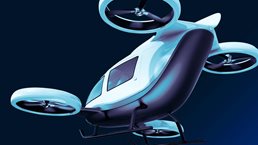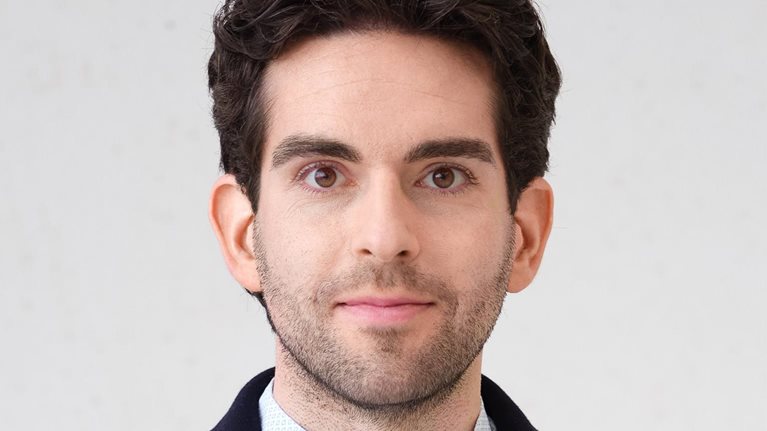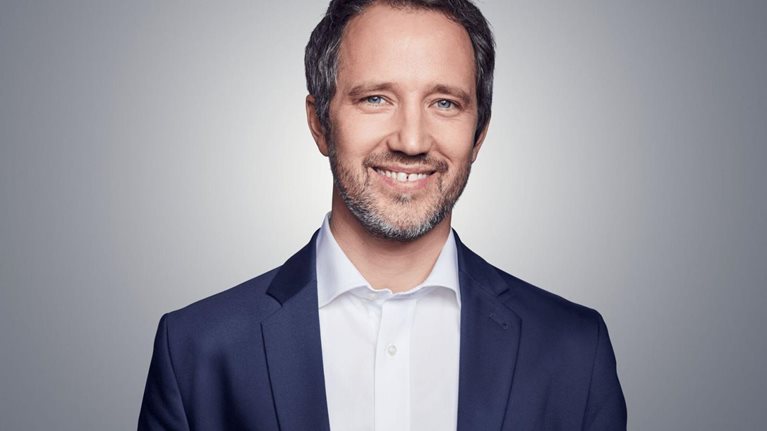“By 2030, Joby Aviation will be the world’s largest airline by departures.” The confidence with which Bonny Simi makes this prediction isn’t surprising when one considers her background: Simi, who is Joby’s head of air operations and people, was a longtime commercial pilot and a US Olympic bobsledder and luger. She was also the founding president of a corporate venture-capital fund. She doesn’t shy away from risk, she’s accustomed to doing things that others find scary, and she likes to go fast.
Joby, founded in 2009 by entrepreneur and engineer JoeBen Bevirt, has developed an electric vertical takeoff and landing (eVTOL) aircraft that seats five people—a pilot and four passengers—and can travel at speeds of up to 200 miles per hour. And it’s gotten the attention of investors and partners: Joby is one of a handful of eVTOL players that went public in 2021. It plans to launch its air-taxi service in 2024.
During a visit to Joby’s facilities in Northern California, McKinsey’s Robin Riedel—himself a certified commercial airline pilot—talked with Simi about Joby’s aircraft, the pilot workforce of the future, and the promise of advanced air mobility (AAM). Edited excerpts of their conversation follow.
Robin Riedel: Let’s look ahead to 2030. What do you imagine the passenger experience will be like in a Joby aircraft? What will people use eVTOL aircraft for?
Bonny Simi: Imagine waking up in the morning and thinking you could drive your car to work—but that might take an hour, an hour and a half. Instead, you just open up an app. A car picks you up and brings you to a heliport five minutes away. You ride in one of our aircraft. The flight takes ten minutes. At the other end, there’s a car waiting for you. The entire ride is seamless, convenient, and affordable.
Initially, aerial ridesharing will simply replace what people currently do. Perhaps it replaces a long commute on a train or ridesharing on the ground. But we believe adoption of aerial ridesharing will grow as people’s lifestyles change. Maybe people will work from home most of the time but go into the office one day a week, and they’ll use our aircraft. Perhaps two people in opposite ends of a city can come together very quickly for an in-person meeting instead of doing it over Zoom, and they’d take our aircraft. Over time, people will move out into the more rural areas, because aerial ridesharing will make it possible to have short daily commutes into the city. This technology just completely changes how you think about work.
It can also change how you think about vacations. Getting to an island will be much quicker and easier. Getting from one side of a city or region to another, even over physical barriers—like mountains—will be much easier.
Our focus currently is on passenger transportation. However, our aircraft could also be used in a whole variety of ways. Think about an area that might be devastated from a hurricane or other natural disaster, where the airports are no longer available and the roads are inaccessible. Our aircraft can move in and land pretty much anywhere in an emergency situation to help transport people and medical supplies. That could be one use case. Last-mile transportation of cargo could be another one. It’s all about where the economics are going to be, and we believe initially that’s in passenger transportation.
Robin Riedel: What geographic areas will likely be the early adopters of AAM? Will it be rural or urban areas? Will it be the Western world or emerging markets?
Bonny Simi: I think the early adopters will be in the large, dense urban centers where congestion is a real problem: Los Angeles, New York, Miami, Singapore, Tokyo, perhaps parts of Brazil. As cities become denser and the roads become more and more congested, trains and buses won’t be able to support everyone’s transportation needs. Over time, though, AAM will be able to connect large metropolitan areas: San Francisco to San Jose, or Santa Barbara to Los Angeles. You ultimately can connect Nagoya to Tokyo, for example. And eventually, AAM will be bringing people from the rural areas into cities.

The future of air mobility: Electric aircraft and flying taxis
What most people get wrong about air taxis
Robin Riedel: What are some of the major misconceptions people have about eVTOL aircraft?
Bonny Simi: One misconception is that these aircraft are noisy. But when we first bring people to see our aircraft fly, the very first thing they remark on is the sound—or the lack thereof. It sounds, even in a hover, like the leaves on a tree. You almost don’t hear it.
It isn’t just the volume; it’s also the quality of sound. When you think of a vertical-lift aircraft, like a helicopter, you hear that “wop-wop.” You don’t hear that with this vehicle at all. And that’s one reason why consumer adoption will be so dramatic.
Another misconception is that aerial ridesharing will be expensive. Joby’s vision is to save a billion people an hour a day—so we are planning for mass adoption. If you want to go from one end of town to the other, or perhaps between two cities, the cost of aerial ridesharing will be the same as ground-based ridesharing. Initially, it’ll be a little bit more expensive, but gradually, as more people take air taxis and the network effects kick in, we’ll get the price point down.
A third misconception is that these aircraft are drones. That’s not accurate: a drone is an aircraft that does not have a pilot in it. Our aircraft is piloted—it’s very safe and it’s easy to incorporate into the existing air-traffic system. Our business model is built to be profitable around a piloted aircraft. Long term, at scale, we think we’ll eventually move toward autonomous aircraft. That will take some time, and we’re not betting our business model on it. But we are exploring autonomy, because to be truly ubiquitous we’ll need to have autonomous aircraft.
Building the pilot pipeline
Robin Riedel: Tell us more about the pilot experience. In a typical pilot training program, trainees have to learn about high-altitude aerodynamics, jet engines, and other things that don’t apply to flying an eVTOL aircraft. How are you thinking about pilot training and building the pilot pipeline?
Bonny Simi: Our aircraft is very intuitive and easy to fly. You can take off and land like a regular airplane on a runway, or you can take off and land vertically—like, on top of a building. It transitions from vertical flight to horizontal flight seamlessly. But our pilots will still need to operate in the regular airspace with other aircraft, so they’ll be subject to the same pilot regulations. We’re training them to fly in a regular general aviation aircraft first. They’ll then transition quickly to our eVTOL aircraft, build up their experience, and launch into commercial operations after they get their commercial license.
As you know, there’s a pilot shortage, so we’re thinking a lot about building a pilot pipeline. We’ve partnered with educational institutions. We want to open up access to pilot training to communities that have never even thought about flying as a career. We’re determined to make the pilot workforce much more diverse. We see this as a big social enterprise as well, and I’m very excited about the directions in which our pilot academy is headed.
Robin Riedel: You brought up diversity. Our research has shown that, globally, less than 6 percent of airline pilots are female. How does Joby plan to address that?
Bonny Simi: When I started flying a few decades ago, the percentage of female pilots globally was in the single digits. Sadly, it’s still the same. Part of the problem is access; another problem is that it’s hard to raise a family when you’re traveling constantly.
At Joby, our aircraft is easy to operate, so the cost for pilot training is very low—which means we’ll be able to open up pilot academies to a diverse population. Also, our focus is on urban air mobility, which means our pilots will be home every night! It makes for a family-friendly operation. We imagine that the workforce of the future for our aircraft will be very diverse, both in gender and ethnicity. So it’s not only environmentally sustainable but also socially sustainable.
‘Electric is now’
Robin Riedel: What else needs to happen to make Joby’s air-taxi service a reality?
Bonny Simi: As we think about building out the entire operation, it’s not just building and certifying the aircraft. That’s an important piece, and it’s what most people are focused on, but we also have to build the infrastructure to run what will be the world’s largest airline.
Part of the infrastructure, of course, is the charging infrastructure. We’ve designed the aircraft for a very quick charge. Our normal stage length—the distance that we’ll fly the aircraft—will be about 25 to 50 miles. It takes just about the same amount of time to charge the aircraft as it does for people to get off and for a new set of passengers to get on—so, roughly five to seven minutes. For flights that are longer, like 150 miles, it could take up to 45 minutes to charge the aircraft. By the way, our aircraft completed a 150-mile flight in July 2021 on a single charge. As far as we know, that set the record for the longest eVTOL flight so far.
Robin Riedel: Do you think Joby aircraft will always be electric? Are electric aircraft the future of aviation?
Bonny Simi: A lot of people say the future of aviation is electric. I say, that’s not the future—that’s now. We’re flying electric aircraft now. What comes next? We believe that hydrogen is next; perhaps first a hybrid of hydrogen and electric, and then ultimately pure hydrogen down the road.
If we think about long-haul travel, hydrogen is the long-term future. For urban air mobility—trips of up to 100 miles—I think electric is ideal. As you begin moving out to regional transportation, it might be a hybrid. And then even farther out than that, it might be pure hydrogen. We believe that in the aviation community broadly, hydrogen will be the standard by 2050.
Robin Riedel: What’s your biggest and boldest prediction about where AAM can go?
Bonny Simi: At Joby, one of our values is “reimagining possible.” So when I think of bold, audacious goals, one is that we will be the largest airline in the world by departures by 2030. Think about that: 1,000 aircraft operating dozens of takeoffs and landings every day. That will make us ubiquitous in the community. Our aircraft will just be a part of people’s everyday life.
Robin Riedel: What’s scarier to you—getting on an eVTOL aircraft for the first time or going down the luge track?
Bonny Simi: Luge and bobsled are not unlike piloting. I actually see a lot of parallels: it’s very much about precision, safety is always paramount, you go fast. But for the riders, trust me: the Joby aircraft is a much smoother ride.
Comments and opinions expressed by interviewees are their own and do not represent or reflect the opinions, policies, or positions of McKinsey & Company or have its endorsement.



